ABSTRACT
The amount of water needed to meet the water requirement of crops and use of alternative organic substrates affect the development of the plants’ nutrients. The objective of this research is to evaluate the cultivation of pepper (Capsicum chinense) under different organic substrates and irrigation levels with supply water and wastewater. The experiment was conducted in a greenhouse at Campina Grande, Paraíba, Brazil. Biquinho BRS Moema pepper species was used. The experimental design was randomized block in a factorial design of 2 x 5 x 2. Two types of water (water supply and wastewater) and five water levels (L) were used based on the water requirement (WR) of the crop as follows: 100% WR (L5), 80% WR (L4), 60% WR (L3), 40% WR (L2) and 20% WR (L1); and two kinds of substrates (caprine and bovine) were also used, all in three replicates with two plants each. The germination percentage for bovine substrate averaged 44%, while for the caprine substrate, it was 18%. 24% increase in the number of leaves at level 4 was compared with that of level 5, where there was 20% reduction of WR of the plant. The pepper "Biquinho" irrigated with wastewater had better average, making it an alternative for irrigation. For the growth of pepper, it is not suitable to use irrigation values less than 40% of the water requirement for culture, because it influences negatively the development of the culture. For pepper, the ideal irrigation level is 80% of water requirement.
Key words: Water reuse, water demand, BRS Moema.
The most commercialized vegetable crop consumed in the world is Capsicum pepper, and about a quarter of the world population consumes pepper as natural, liquid sauces, canned or dehydrated (Silva et al., 2015). Also smaller sizes are used as ornamental plant; it is used as family farms, and for agribusiness (Xavier et al., 2006).
Pepper is a crop with good productivity, and generally profitable for producers; it has greater rusticity on the field and longer cycle and may be harvested for more than one year (Hortifruti Brazil, 2015).
In Brazil pepper is the second most exported vegetable, contributing 13.5% of total production. Due to the increased consumption and interest of exporters, pepper cultivation is a trade of big importance, involving various sectors, from small to multinational farmers (Informa Economics F. N. P., 2012). In this way, pepper cultivation should be studied to provide quality and alternatives in its management. This information will be beneficial to its producers.
Organic substrates are an alternative to reduce costs in pepper cultivation. Almeida et al. (2012) state that the ideal substrate should be easily acquired, transported and have nutrient (Kusdra et al., 2008). The proper pH of the substrate must have good texture and structure (Silva et al., 2012).
The substrate must have bovine manure, because according to Silva et al. (2007), it is the main organic fertilizer used to improve the fertility of the Brazilian semiarid region soils. However, the use of caprine manure is a promising alternative for substrate composition (Pereira et al., 2012).
For pepper cultivation, the types of substrate and water used are important because they provide the proper environment and nutrients for the plant development. In regions with water shortage like the Brazilian semiarid regions, irrigation with wastewater is an alternative that helps the production of pepper, and also the environment, because it makes necessary the reuse of water. For Medeiros et al. (2008), the benefits of water reuse are conservation of available water, its wide availability, possibility of intake and nutrient recycling, preservation of the environment. There are few studies on pepper cultivation. It is important to consider the type of substrate and the amount of water needed at each stage of the cycle of the plant in order to obtain maximum development during the entire cycle in a sustainable manner with use of organic substrates and water reuse.
The efficiency of the use of water in irrigation reduces water loss and also supplies the water requirement of the plant for its best development. Irrigation management aims to supply the water requirement of the crop to some extent without deficit or excess. It is very important that irrigation management is done properly, to obtain success in yield and also preserves the environment (Gomes and Testezlaf, 2007).
The research was carried out to evaluate the cultivation of pepper (Capsicum chinense) under different organic substrates and irrigation levels with water supply and wastewater.
The investigation was carried out in a greenhouse, at Campina Grande, PB, Brazil, in 2014. The greenhouse is located at an altitude of 550m above mean sea level and it is 7º15’18” latitude and 35°52’28” longitude. The climate is classified as Bswh according to the Köppen classification system, with an average annual temperature of 26.8°C and an average annual rainfall of 360 mm. Cultivar BRS Moema pepper “Biquinho” (C. chinense) seeds planted in a substrate by the company ISLA Seeds, were used in this experiment. For the propagation, seeds were planted directly on the cultivation site, 0.5 cm deep, as recommended by the company.
For the experiment 60 black plastic pots (no. 17) were used with a capacity of approximately 1.6 L, with the following dimensions: top diameter, 15 cm; bottom diameter, 9 cm and height, 14 cm. For the drainage six holes were made and a protection screen was placed at the bottom of the pots. They were then filled with crushed stones (no. 0), covering all the bottom and the substrate (soil: manure, 7:3); there was 70% soil and 30% manure, on a volume basis.
The experiment was laid out in a randomized block, in a 2 x 5 x 2 factorial design; it is composed of two types of water: supply water (A1) and wastewater (A2), five water levels based on crop water requirement and two types of substrate: bovine manure (S1) and caprine manure (S2). The five irrigation levels (L) using supply water and wastewater were treated by an up flow anaerobic sludge blanket reactor (UASB + WETLAND), based on crop water requirement (WR): 100% of WR (L5), 80% of WR (L4), 60% of WR (L3), 40% of WR (L2) and 20% of WR (L1).
They were evaluated daily until 14 days after sowing (DAS); the germination percentage (GP) was based on Labouriau and Valadares (1976) and the Emergence Speed Index (ESI) was determined by Maguire (1962). From 23 days after sowing (DAS) the following evaluations were carried out weekly: growth and development of the plant, plant height (PH) measured from the soil until the apex of the plant; stem diameter (SD) close to the soil; number of the leaves (NL).
Data were analyzed using the statistical software SISVAR (Ferreira, 2014) and the difference between treatment means was assessed by the Tukey test, at 5% probability.
Figure 1 shows the germination percentage for bovine substrate averaged 44.4%, while for the caprine substrate, it was 18.64%. These results show the efficacy of bovine substrate in the early stages of the pepper. The use of bovine substrate increases the percentage of germination in about 26%. After 30 days of sowing percentage of germination of the varieties “Girl Finger” (TECNOSEED), “Tabasco” (TOP SEED), “Volcano 2011” and “Bishop Hat 2012” had, respectively, 34, 25, 5 and 0% germination (Silva et al., 2013).
While 14 days after sowing, the “Biquinho” pepper in organic substrates at different water levels was 36.3%, as shown in Figure 2. For the emergence speed index (ESI) the highest average, according to Figure 2, was L1 (20% WR) with 1.44 germination/day. Similar results of ESI were obtained by Magalhães et al. (2011) studying the emergency of Chili pepper at several concentrations of CO2, with 2.23 to seedlings/day; whereas, for the “Girl Finger” pepper was 0.92 to 1.42 seedling/day, varying according to the carbon dioxide concentrations (550 and 360 ppm).
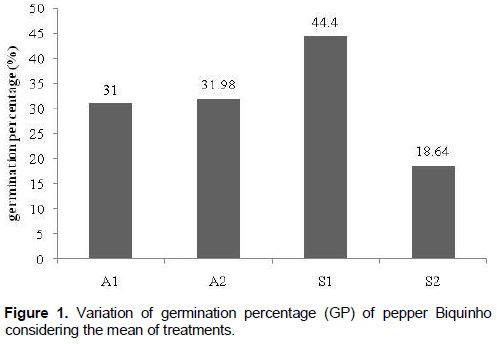
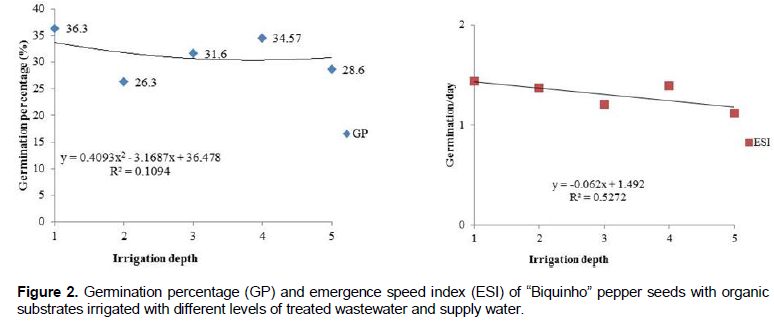
In the germination of Biquinho pepper, it was observed that only 20% of the water requirement of culture was sufficient in tolerating decreased water content in the soil; thus making the seeds to germinate under deficits water. Similar results were obtained by Silva et al. (2014) on the germination of irrigated Biquinho pepper with water blades and wastewater; they found best results at 20 to 80% of the water requirement. According to Paiva et al. (2012), irrigation using wastewater for chili resulted in better performance.
The use of wastewater and bovine substrate resulted in better average results for plant height in all assessments, with continued growth (Table 1). Using wastewater to produce pepper seedlings, okra and tomato, Oliveira et al. (2012a) and Alves et al. (2012) had higher crops. In producing pepper seedlings Malagueta and Tequila Sunrise, Oliveira et al. (2012b) had better results, using 75% of wastewater. This study found positive effects with higher averages in plants irrigated with wastewater treated.
With bovine substrate, the plant height average was higher than that of caprine substrate, as shown in Table 1. Evaluating different substrate compositions (topsoil, washed sand, commercial substrate, caprine and bovine manure) in the yield of ornamental pepper (Capsicum annuum L.), Da Silva et al. (2013) achieved lower results for the height of pepper. Silva et al. (2010) achieved lower mean for chili height (10.7 cm) in substrates whose mixture had humus. Nascimento et al. (2015) analyzed the influence of water stress on the nozzle of pepper cultivated with goat substrate; they observed similar results with an average height of 14.53 to 13.70 cm using wastewater and supply water at 177 DAS.
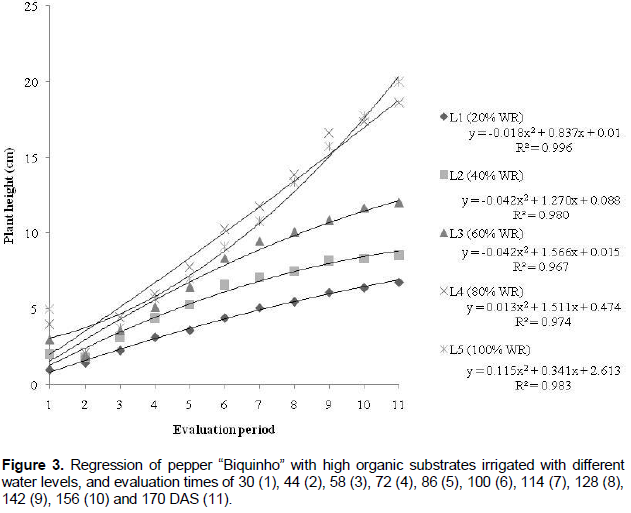
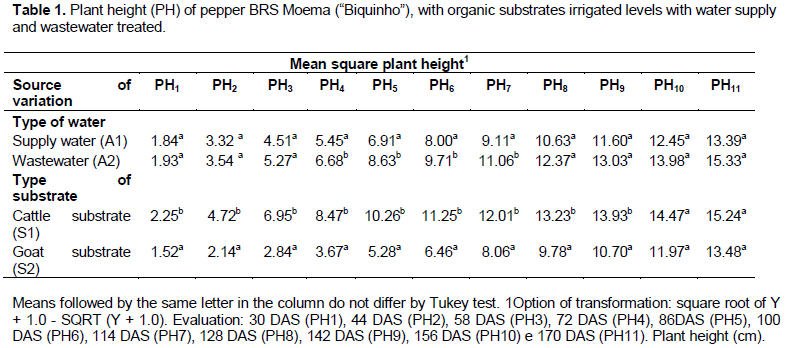
As shown in Figure 3, the irrigation levels applied are directly proportional to plant height, and its linear growth. The highest means were obtained in L5 (100% WR) and L4 (80% WR), providing better development in plants. Reduction of irrigation levels resulted in plants of smaller sizes. This result is interesting, because smaller plants are easily managed, and also for ornamental purposes. At 170 DAS (11), the pepper plant’s height ranged from 7.43 to 23 cm (67.69%); it was checked to compare the smaller and larger irrigation depth. It shows that by reducing the amount of water available to plant for drought stress, the metabolism of the culture is affected. The irrigation level for a higher average height “Biquinho” pepper is 100% WR in this study; it is similar to that achieved by Aragão et al. (2011), who studied different irrigation levels of Magali R. They observed a higher average height, using up to 100% of Eto. Barcelos et al. (2015) submitted that the red sweet pepper nozzle potassium doses reach 3.7 cm height.

In Table 2, the analysis of variance for the number of leaves (NL), and the source of water was significant at NL2 (30 DAS) and NL5 (86 DAS) reviews. Biquinho grown peppers with goat substrate and irrigated treated wastewater and supply averages were superior at 51 and 93 DAS; supply water had the best average until the end of the experiment; at 177 DAS, it ranges from 16.33 to 19.13 leaves per plant (Nascimento et al., 2015).
In research conducted with commercial substrate in the yield of seedlings of three black pepper genotypes, Serrano et al. (2012) observed the number of leaves for an average of 11.1 (Gajarina), 11.0 (Iaçara) and 12.9 (Singapore). Corroborating with the results of these authors, the “Biquinho” pepper with bovine substrate produced an average of 15.4 leaves at 144 DAS, and with caprine substrate an average of 19.34 leaves at 170 DAS; indicating that organic substrates used propitiated conditions favorable to the crop.
As shown in Figure 4, there was a quadratic regression trend in the number of leaves. The L4 level (80% WR) and L5 level (100% WR) had better results when compared to other irrigation levels. By regression analysis, there was a 24.44% increase in the number of leaves in the L4 when compared with L5, where there was reduction of 20% of water available to the plant. When comparing L3 with L4, improving water availability by 20%, there is an increase in the number of leaves of 55.2%. The L4 irrigation level was considered adequate influencing positively the amount of pepper leaves. In the number of sheets of the nozzle pepper there was an increase in the number of sheets when there is increased availability of water based on the water requirement (80% (L4) and 100% (L5)).
By studying the tomato growth rates at different irrigation levels, Soares et al. (2011) had lower results; they reported an increase in the number of leaves, increase in water availability (20%) of the reference evaporation. There was an increase of 29.45% in the amount of leaves between irrigated plants. Silva et al. (2012), studying lettuce growing culture, saw a greater amount in number of leaves of plants irrigated with the blade, 125% ET0.
The plants irrigated with wastewater had the best averages and bovine substrate had superior results when compared to the substrate goats. At 170 (SD11), the nozzle pepper irrigated with wastewater had an average of 5.39 mm, and when irrigated with the average supply of water it is 5.17 mm and approximately 0.22 mm difference (Table 3). The wastewater had in all evaluations higher values when compared to the water supply. Costa et al. (2009) confirmed it on studying the stem diameter of the corn stalk. SD was higher for plants receiving wastewater compared to the results of plants that received water supply.
Comparing the values ​​obtained with the stem diameter of the “Biquinho” pepper under different types of fertilizers obtained by Pagliarini et al. (2014), there was an average of 3.07 to 4.44 mm; while the values ​​obtained in this experiment with bovine and caprine substrate under different water levels were higher. Silva et al. (2013), in producing ornamental pepper (C. annuum L.) with different substrate compositions, observed that the stem diameter of the pepper changed from 2.2 of 4.4 mm. According to Figure 5, L4 (80% WR) and L5 (100% WR) had better average as compared to other levels. To reduce 20% of the water requirement, there was a decrease of 15.8% in stem diameter in L4 levels and L3 levels. Comparing L2 with L1, there was an increase of 13.16% in stem diameter. It is noted that the highest means were obtained with irrigation levels of 80% of the water requirement of the crop.
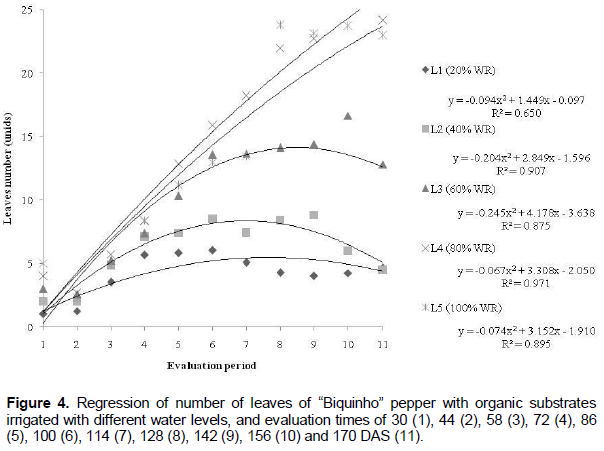
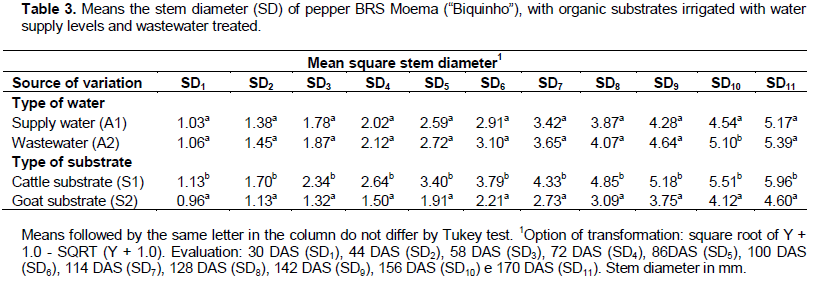
Silva et al. (2012), studying the effect of percentages (125, 100, 75, 50 and 25%) on the actual daily evapotranspiration of lettuce, Saia Veia (Lactuca sativa L.), it was found that plants irrigated with different water levels had significantly different stem diameter in treatments 25, 50 and 125% of Eto; there was increased stem diameter in the blade at 125% of Eto. The nozzle pepper increased in all slides, but the greatest diameter was for the replacement of 80 and 100% of the water requirement.
Reducing the diameter of the stem is directly related to increased water replacement levels. Soares et al. (2011) found similar results for tomato cultivation; so drought in the vegetative and reproductive phase provides lower height of plants, number of leaves and stem diameter. Analyzing the development of the coffee conilon it was found that drought reduced the stem diameter of this species (Dardengo et al., 2009). In rosemary-pepper cultivated at different irrigation levels, Alvarenga et al. (2012) and Figueiredo et al. (2009) observed better growth occurring with greater water availability.
The bovine substrate used in BRS Moema pepper cultivation had the best results for the development of the crop. The caprine substrate can be applied, but the pepper trees would be small, making it ideal for ornamentation.
The wastewater used for irrigation of pepper is an alternative of water reuse in agriculture, reducing costs, providing nutrients for the plants and resulting in better averages, so, more shrubby pepper. The L4 irrigation (80% WR) and L5 (100% WR) were the water supply needs of pepper BRS Moema; they are favorable conditions for the crop. So, the plants irrigated with 80% WR allows for proper development of the pepper, saving water.
The authors have not declared any conflict of interests.
REFERENCES
|
Almeida LVB, Marinho CS, Muniz RA, Carvalho AJC (2012). Disponibilidade de nutrientes e crescimento de porta-enxertos de citros fertilizados com fertilizantes convencionais e de liberação lenta. Rev. Bras. Fructic. 34(1):289-296.
Crossref
|
|
|
|
Alvarenga ICA, Lopes OD, Pacheco FV, Oliveira FG, Martins ER (2012). Fator de resposta do alecrim-pimenta a diferentes lâminas de irrigação. Rev. Pesq. Agropec. Trop. 42(4):462-468.
Crossref
|
|
|
|
|
Alves RC, Ferreira Neto M, Nascimento ML, Oliveira MKT, Linhares PSF, Cavalcante JSJ, Oliveira FA (2012). Reutilização de água residuária na produção de mudas de tomate. Agropecu. Cient. no Semiárido 8(4):77-81.
|
|
|
|
|
Aragão VF, Fernandes PD, Filho Gomes RR, Neto Santos AM, Carvalho CM, Feitosa HO (2011). Efeito de diferentes lâminas de irrigação e níveis de nitrogênio na fase vegetativa do pimentão em ambiente protegido. Rev. Bras. Agric. Irrigada 5(4):361-375.
Crossref
|
|
|
|
|
Barcelos MN, Silva EM, Maruyama WI (2015). Produção de duas espécies de pimenta biquinho doce submetido a diferentes substratos. In: Congresso técnico cientifico da engenharia e da agronomia- Fortaleza, Ceará.
|
|
|
|
|
Costa FX, Lima VLA, Beltrão NEM, Azevedo CAV, Soares FAL, Alva IDM (2009). Efeitos residuais da aplicação de biossólidos e da irrigação com água residuária no crescimento do milho. Rev. Bras. Eng. Agric. Ambient. 13(6):687-693.
Crossref
|
|
|
|
|
Da Silva NJJ, Rêgo ER, Barroso PA, Nascimento NFF, Batista DS, Sapucay MJLC, Rêgo MM (2013). Influencia de substratos alternativos para produção de pimenteira ornamental (Capsicum annuum L.). Agropecu. Téc. 34(1):21-29.
|
|
|
|
|
Dardengo MCJD, Reis EF, Passos RR (2009). Influência da disponibilidade hídrica no crescimento inicial do cafeeiro conilon. Biosci. J. 25(6):1-14.
|
|
|
|
|
Ferreira DF (2014). Sisvar: a Guide for its Bootstrap procedures in multiple comparisons. Ciênc. Agrotec. 38(2):109-112.
Crossref
|
|
|
|
|
Figueiredo LS, Bonfim FPG, Siqueira CS, Fonseca MM, Silva AH, Martins ER (2009). Efeito da época de colheita na produção de fitomassa e rendimento de óleo essencial de alecrim-pimenta (Lippia sidoides Cham.). Rev. Bras. Plantas. Med. 11(2):154-158.
Crossref
|
|
|
|
|
Gomes EP, Testezlaf R (2007). Manejo de irrigação na tomaticultura-de-mesa.39 p.
|
|
|
|
|
Hortifruti Brasil (2015). Ervas e especiarias. O complemento que faz toda diferença. Available at: http://hortifrutibrasil.blogspot.com.ng/2015_07_01_archive.html
|
|
|
|
|
Informa Economics F. N. P. (2012). Agrianual 2012–anuário da agricultura brasileira. Informa Econ. FNP: São Paulo.
|
|
|
|
|
Kusdra JF, Moreira DF, Silva SS, Araújo Neto SE, Silva RG (2008). Uso de coprólitos de minhoca na produção de mudas de mamoeiro. Rev. Bras. Fructic. 30(2):492-497.
Crossref
|
|
|
|
|
Labouriau LG, Valadares MB (1976). On the germination of seeds of Calotropis procera. Acad. Bras. Ciênc. 48(1):174-186.
|
|
|
|
|
Magalhães EE, Angelotti F, Peixoto AR, Pinheiro G, Fernandes HA, Lopes AP, Silva RCB, Dantas BF (2011). Emergência de pimenta sob aumento da concentração de CO2. 239 p.
|
|
|
|
|
Maguire JD (1962). Speed of germination aid in selection and evaluation for seedling emergence and vigor. Crop Sci. 2(1):176-177.
Crossref
|
|
|
|
|
Medeiros SS, Soares AA, Ferreira PA, Neves JCL, Souza JA (2008). Utilização de águas residuárias de origem doméstica na agricultura: Estudo do estado nutricional do cafeeiro. Rev. Bras. Eng. Agric. Ambient. 12(2):109-115.
Crossref
|
|
|
|
|
Nascimento ECS, Silva VF, Andrade LO, Lima VLA (2015). Estresse hídrico em pimenteiras orgânicas com aplicação de diferentes lâminas de água residuária. In: Congresso Técnico Científico da Engenharia e da Agronomia - Fortaleza- Ceará.
|
|
|
|
|
Oliveira JD, Alves SMC, Ferreira NM, Oliveira RD (2012). Efeito da água residuária de esgoto doméstico tratado na produção de mudas de pimenta cambuci e quiabo. Enciclopédia Biosfera Goiânia 8(14):443-452.
|
|
|
|
|
Oliveira JD, Alves SMC, Neto MF, Oliveira RD, Paiva LD (2012). Produção de mudas de pimenta malagueta e pimenta tequila Sunrise fertirrigadas com efluente doméstico tratado. Enciclopédia Biosfera, Centro Científico Conhecer Goiânia 8(15):1400-1411.
|
|
|
|
|
Pagliarini MK, Castilho RMM, Mariano FAC (2014). Desenvolvimento de mudas de pimenta de bico em diferentes fertilizantes. Rev. Bras. Hortic. Ornam. 20(1):35-42.
Crossref
|
|
|
|
|
Paiva LAL, Alves SMC, Batista RO, Oliveira JF, Costa MS, Costa JD (2012). Influência da aplicação de esgoto doméstico terciário na produção de mudas de pimenta malagueta. In: Inovagri International Meeting & IV Workshop Internacional de Inovações Tecnológicas na Irrigação.
|
|
|
|
|
Pereira DL, Oliveira RH, Souza EGF, Ferraz APF, Coelho Junior LF, Barros Junior AP (2012). Uso de fontes orgânicas como substrato na produção de mudas de melão. Rev. Hortic. Bras. 30(2):5559-5605.
|
|
|
|
|
Serrano LAL, Marinato FA, Magiero M, Sturm GM (2012). Produção de mudas de pimenteiras-do-reino em substrato comercial fertilizado com adubo de liberação lenta. Rev. Ceres 59(4):512-517.
Crossref
|
|
|
|
|
Silva BR, Schardosim SE, Selau DE, Candia ASF, Seibert E (2013). Avaliação da germinação e do desenvolvimento das mudas de diferentes variedades de pimentas. In: 2º Simpósio de Integração Científica e Tecnológica do Sul Catarinense – SICT-Sul.
|
|
|
|
|
Silva HW, Costa LM, Resende O, Oliveira DEC, Soares RS, Vale LSR (2015). Higroscopicidade das sementes de pimenta (Capsicum chinense L.). Rev. Bras. Eng. Agric. Ambient. 19(8):780-784.
Crossref
|
|
|
|
|
Silva OS, Souza RB, Takamori LM, Souza WS, Silva GPP, Sousa JMM (2010). Produção de mudas de pimentão em substratos de coco verde fertirrigadas com biofertilizante em sistema orgânico. Rev. Hortic. Bras. 28(2):2714-2720.
|
|
|
|
|
Silva PF, Silva CH, Santos JCC, Santos MAL, Santos DP (2012). Avaliação de diferentes lâminas de água na cultura da alface (Lactuca sativa L.) na região Alagoana. In: 8º Simpósio Brasileiro de Captação e Manejo de Água de Chuva, Campina Grande- PB.
Crossref
|
|
|
|
|
Silva TO, Menezes RSC, Tiessen H, Sampaio EVSB, Salcedo IH, Silveira LM (2007). Adubação orgânica da batata com esterco e, ou, Crotalaria juncea. I. Produtividade vegetal e estoque de nutrientes no solo em longo prazo. Rev. Bras. Ciênc. Solo 31(1):39-49.
Crossref
|
|
|
|
|
Silva VF, Nascimento ECS, Andrade LO, Baracuhy JGV, Lima VLA (2014). Efeito do substrato bovino na germinação de pimenta biquinho (Capsicum chinense) irrigado com água residuária. Rev. Monogr. Ambient. 13(5):3865-3871.
Crossref
|
|
|
|
|
Soares LAA, Lima GS, Brito MEB, Araujo TT, Sa FVS (2011). Taxas de crescimento do tomateiro sob lâminas de irrigação em ambiente protegido. Rev. Verde Agroecol. Desenvolv. Sustentável 6(2):210-217.
|
|
|
|
|
Xavier VC, Ferreira OGL, Moraes RMD, Morselli TBGA (2006). Concentração da solução nutritiva no cultivo hidropônico de pimenta ornamental. Rev. FZVA 13(1):24-32.
|
|